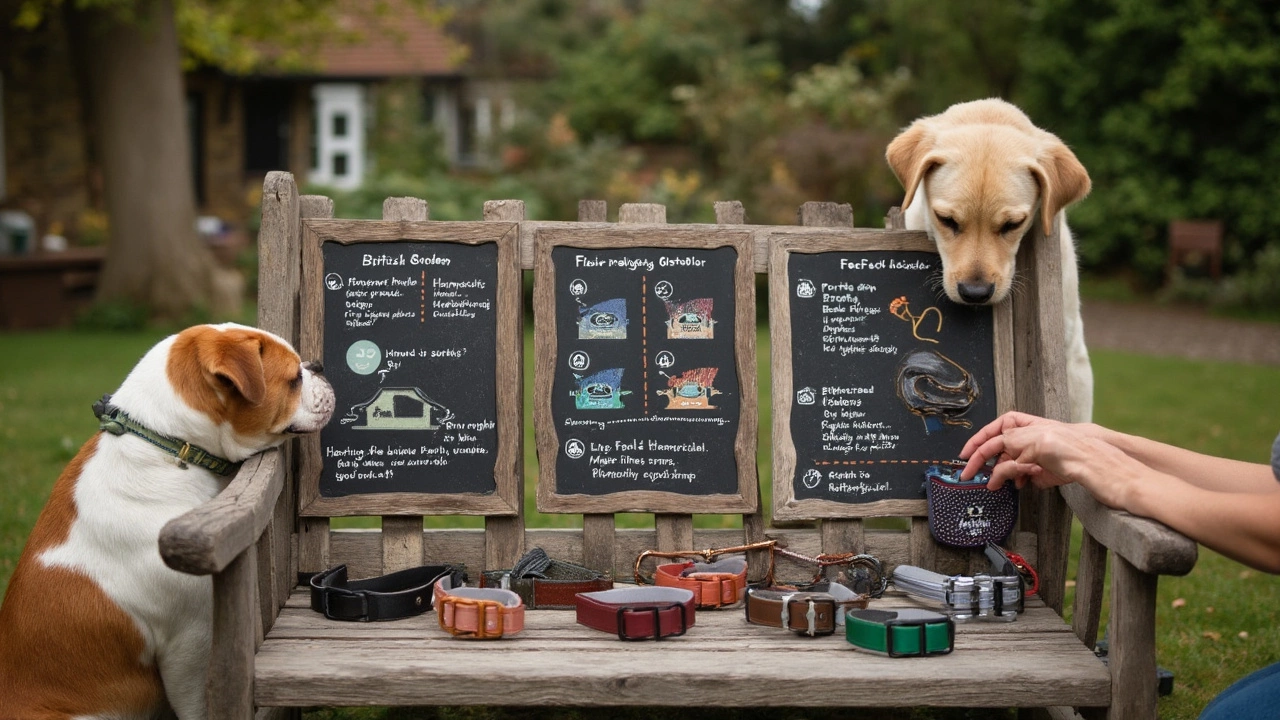Seeing Cesar Millan work with a rowdy dog can leave anyone wondering—what's the secret behind his control? Years ago, on "The Dog Whisperer," he’d snap fingers, hiss, and—surprisingly—use training collars. For many viewers, the sight of a slip lead or a prong collar was eye-opening or even shocking. If you’ve ever walked past a pet shop aisle packed with harsh-looking collars, you might have thought, “Are those things really necessary?” Some swear by them; others call them cruel. But Cesar? He’s never been shy about using all sorts of training collars when the situation demands it. Let’s look at what tools he uses, why, and what you can really expect if you follow his lead.
Which Training Collars Does Cesar Millan Actually Use?
Cesar’s toolkit is bigger than most people realize. On his shows, you’ll see him reach for different types of collars—sometimes a plain old slip lead (that’s just a loop of rope with an adjustable slider), sometimes a martingale or a prong collar, and occasionally, even a remote-controlled electronic collar. His go-to? The classic slip lead. It’s fast, easy, and, in the right hands, doesn’t hurt the dog. He uses it to communicate with quick leash pops and corrections, not to choke or punish.
But what about the famous prong collar? Cesar’s used those too, especially for dogs who pull hard or ignore milder corrections. He insists these collars, if used properly, aren’t dangerous. The prongs sit flat against the dog's neck, tightening only when the dog surges ahead—and releasing instantly with slack. They aren’t meant to dig in or hurt. Cesar often compares them to a mother dog's teeth correcting her pups. Still, that’s a controversial point, and many trainers disagree with the analogy.
The rarest in his arsenal: the electronic collar. You won’t see it in most episodes, but in some extreme cases, he’s used remote collars to reinforce commands. He always prefaces this by saying e-collars should never be used as punishment but as a last resort, and only after other methods (and with a professional's guidance). It’s telling that he’s careful not to reach for the toughest tool first.
Here’s a quick comparison of the main collars Cesar Millan uses:
| Collar Type | Main Use | How It Works | Risks |
|---|---|---|---|
| Slip Lead | Everyday walking & corrections | Tightens evenly around neck with tension | Can choke if misused |
| Prong Collar | Strong pullers & tough corrections | Even pressure from prongs when pulled | Potential discomfort or injury if jerks are too harsh |
| Electronic Collar | Extreme cases only | Delivers vibration, tone, or mild shock as signal | High risk of fear or stress if misused |
To sum up: Cesar Millan definitely uses training collars. But he switches between tools depending on the dog and the problem, not because he likes to be tough. He says it’s about clear communication, timing, and reading the dog—not brute force. Want to try something he does? Cesar always reminds owners to keep calm energy, gentle but clear hands, and short, clear corrections. The collar is just a tool, not the solution in itself.

Why Does Cesar Millan Use Training Collars, and Are They Safe?
This is where debate heats up in the dog world. Cesar Millan believes training collars can be safe if they’re used correctly and only for a purpose: to interrupt dangerous behavior, grab a distracted dog’s attention, or stop pulling with a gentle correction. But here’s the catch—he has decades of practice under his belt. A poorly timed leash pop or a collar that’s too tight can scare a dog, hurt their neck, or even make behavior problems worse.
He says it’s never about pain—it’s about redirecting the dog’s mind back to you, fast. If you’ve seen him in action, you know he reads a dog’s body language like a pro. He’ll step in before a bark explodes or a lunge begins, using the collar just for an instant. Most of the time, he combines this tool with voice, body language, and that famous calm-assertive energy. It’s not magic. It’s decisive, quiet communication.
Critics argue that collars—especially prongs and e-collars—can cause pain or teach a dog to fear you. The American Veterinary Society of Animal Behavior, for example, has spoken out against the use of aversive collars, warning that they can create anxiety, not trust. There’s even data to back this up: a 2020 study in the journal “PLOS ONE” found that dogs trained exclusively with aversive tools were more likely to show signs of stress and less likely to learn reliably than those trained using positive methods only.
But Cesar’s answer isn’t black-and-white. He points out that some owners are physically unable to control big, powerful dogs with just treats and patience. In these cases, using a training collar under supervision might keep both dog and human safe. For him, it’s about the balance between physical and mental correction—never about punishment or fear. The proof is in the results: many of the dogs he helps are on their last chance before the shelter, with aggression or deep-seated trauma. Sometimes, a training collar is the tool that keeps a dog in a home rather than out on the street.
If you’re curious about trying one of these collars, here are Cesar’s key safety tips:
- Have a professional trainer show you how to fit and use any specialized collar before trying it alone.
- Never jerk, yank, or keep constant tension on a training collar.
- Start with the least invasive tool—often a slip lead or martingale.
- Watch your dog’s reaction closely; if you see fear, stress signals, or pain, stop and reassess.
- Remember that tools are for rare corrections—95% of training happens with patience, boundaries, and leadership.
Cesar also tells dog owners to get educated instead of copying TV tricks. What works in his expert hands isn’t always safe for a first-timer. New research keeps tipping the conversation toward reward-based training for most situations, but there’s no one-size-fits-all rule. Don’t trust anyone who tells you there is. When in doubt, find a pro who can guide you and your pup safely.

The Debate: Training Collars, Positive Reinforcement, and What Actually Works
If you ask ten trainers about Cesar Millan’s collars, you’ll get ten arguments. Some see him as a master of canine communication; others call his approach outdated. Over the past decade, the science of dog behavior has shifted hard toward positive reinforcement: treats, toys, praise, and patience. Countries including Sweden, Finland, and parts of Germany have even banned prong and choke collars outright, saying the risks outweigh the benefits.
Cesar never ignores this debate. He admits that he’s not against treats and reward-based training. In fact, on his more recent shows and YouTube videos, you’ll spot him handing out food and encouragement as often as leashing up a collar. He says what matters isn’t the collar, but how the human uses it. Lose your temper or turn to physical force? You’re not training—you’re scaring your dog. But if you stay calm, focused, and treat the collar as just one tool, not the star of the show, you’re closer to the middle ground many trainers now recommend.
Here's a snapshot of what research and modern trainers are saying about different dog training approaches:
| Method | Effectiveness | Typical Tools | Common Risks |
|---|---|---|---|
| Traditional/Correction-based | Works fast for urgent or risky behaviors | Slip leads, prong collars, e-collars | May cause stress, fear, or aggression if misapplied |
| Positive Reinforcement | Builds trust and motivation for most dogs | Treats, toys, clickers | Can be slower for urgent cases; less effective with high-arousal dogs |
| Balanced Training | Combines rewards and light corrections | Martingales, gentle correction collars, treats | Depends on handler skill; can slip into harsher territory |
Tips if you’re facing a tough behavior problem:
- If rewards and redirection aren’t cutting it, consult a modern dog trainer who’s experienced with balanced methods. Don’t jump straight to collars without skilled support.
- Most collar-related injuries happen because of poor fit, rough corrections, or unsupervised use. Never leave a dog alone in a training collar.
- Don’t play copycat—what you see on TV is chopped, edited, and supervised by professionals.
- Measure your dog's neck and fit any training collar snugly but not tightly. You should be able to slip two fingers under it.
- Remember: real progress happens at home, with daily routines and calm energy. The collar is the paintbrush—your relationship is the canvas.
The Cesar Millan method isn’t for everyone. Some owners find collars empowering, while others feel uneasy—not just for ethical reasons, but because they know their own limits handling energetic, unpredictable dogs. And that's okay. The goal isn’t to turn every owner into a mini Dog Whisperer, but to help you build a calm, respectful relationship with your dog—using the tools that suit both of you best.
Whatever method you choose, knowledge beats equipment. Get to know your dog’s energy signals, body language, and triggers. Get support, ask questions, and adjust based on results, not rigid rules. Training collars can be helpful tools in experienced hands, but there’s no shortcut past real understanding. You, not the collar, are the key to your dog’s behavior change.
